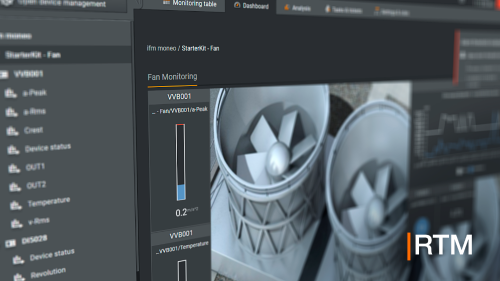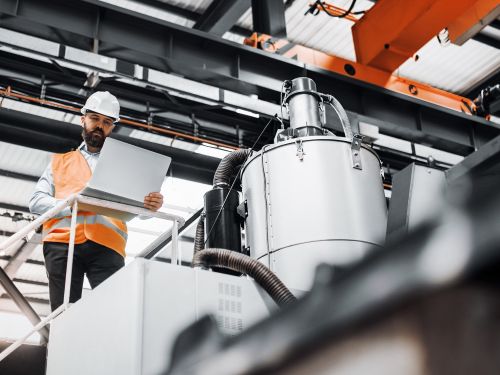Machine tool: Energy meter with Modbus TCP interface
Electrical energy monitoring of a machine tool
Metering, visualisation and analysis of electrical energy using energy meters with Modbus TCP interface and moneo RTM. Due to the complexity of a machine tool, special attention in terms of monitoring is advisable from the perspective of energy. From a physical perspective, various consumers are installed here that affect the production of inductive and capacitive power in different ways. This can have a significant effect on energy costs.
The starting position
Without selective monitoring, the electrical energy requirement can only be determined as a total value. There is no way to assign the electrical energy requirement to the individual applications and workpieces. The magnitude of the active and apparent power and the energy requirement per workpiece are unknown energy components.
Goal of the project
Transparent energy requirement for optimisation of energy consumption
The energy requirement of the machine tool will be measured and saved so it is available for later analysis. This is done by measuring the reactive, apparent and active power and determining the power factor.
Implementation
The energy supply of the machine park is ensured by conductor rails located under the ceiling. The machine tool is connected via an outlet box, which also protects the machine tool against overcurrent.
To record all the data for the energy requirement of the machine tool, a three-phase energy meter with Modbus TCP interface was installed and connected in this outlet box.
LR Agent enables reliable reading of the required Modbus registers. In moneo RTM, the values are monitored and analysed and consumption costs are immediately calculated.
Success
Keeping an eye on electrical consumption levels and machine status
Transparent energy requirement with moneo RTM
- Measure electrical energy consumption by process/work area.
- Information about electrical energy consumption all in one place.
- Calculates the cost of electrical energy consumption in the scaled range.
- Indicates the total power consumption
- Indicates the current power consumption
- Indicates the current voltage, current and power for all three phases
- Indicates the current reactive currents and reactive power produced
- Indicates the total reactive currents and reactive power produced
- Enables calculation of total costs via Calculated values
- Enables calculation of current costs via Calculated values
- derive consumption values: total consumption, peak consumption, base load consumption / standby, consumption during non-production time, reactive currents and reactive power produced
System structure

- Siemens 7KT1260 energy meter
- LR Agent

Dashboard
The dashboard provides the user with an overview of the relevant process values for this plant.

- Phase 1 (L1): current measured current, voltage and power values
- Phase 2 (L2): current measured current, voltage and power values
- Phase 3 (L3): current measured current, voltage and power values
- Current costs per hour + current power requirements
- Total costs + total power requirements

- Phase 1 (L1): current power factor, apparent power and reactive power
- Phase 2 (L2): current power factor, apparent power and reactive power
- Phase 3 (L3): current power factor, apparent power and reactive power
- Overall power factor
- Total apparent power (+/-)
- Total reactive power (+/-)
Analysis
When the reactive power produced is evaluated in the moneo analysis, it can be seen that the machine tool is operating in a very unfavourable range. The power factor is primarily in the negative range during operation.
There is an urgent need to examine and eliminate the cause. In the case specifically described here, however, no measures will be implemented because the machine tool will only be in this location for a limited time and from a business perspective it is not worthwhile to compensate for the reactive power over that time.
The data will be recorded and used to design the reactive power compensation system for the new, long-term location.

- Power factor
- Current active power consumption

- Reactive power L1
- Reactive power L2
- Reactive power L3
- Current active power consumption
Calculated values: Calculated values
Data flow for converting watts to kW
The measured variables provided by the energy meter in the Modbus registers are read using LR Agent and booked into moneo. However, they do not always appear in the desired unit. Power values are typically expressed in kW. The standard SI unit is Watt, which is also used in the registers. Using a data flow function, the input variable (W) can be converted into the desired unit (kW).

- Active power in W
- Constant: divisor for conversion to kW
- Division
- Active power in kW
Equally helpful for evaluating and analysing the consumption values is to calculate the costs of power consumed. These are usually billed by the energy supplier in kilowatt hours. The basic parameter used for this calculation is the input power converted into kilowatt hours in the previous data flow. Two data flows are created:
1. Cost calculation of current power consumption

- Active power in kW
- Constant: cost per kilowatt hour
- Multiplication
- Rounding to 2 decimal places
- Current costs per hour
2. Cost calculation of total power consumption

- Current costs per hour
- Constant: cost per kilowatt hour
- Multiplication
- Rounding to 2 decimal places
- Total costs


